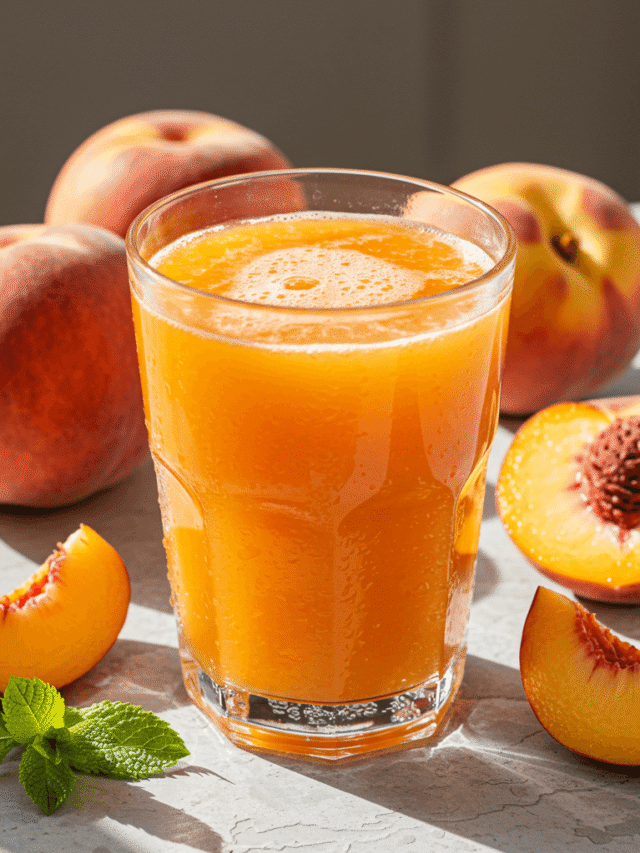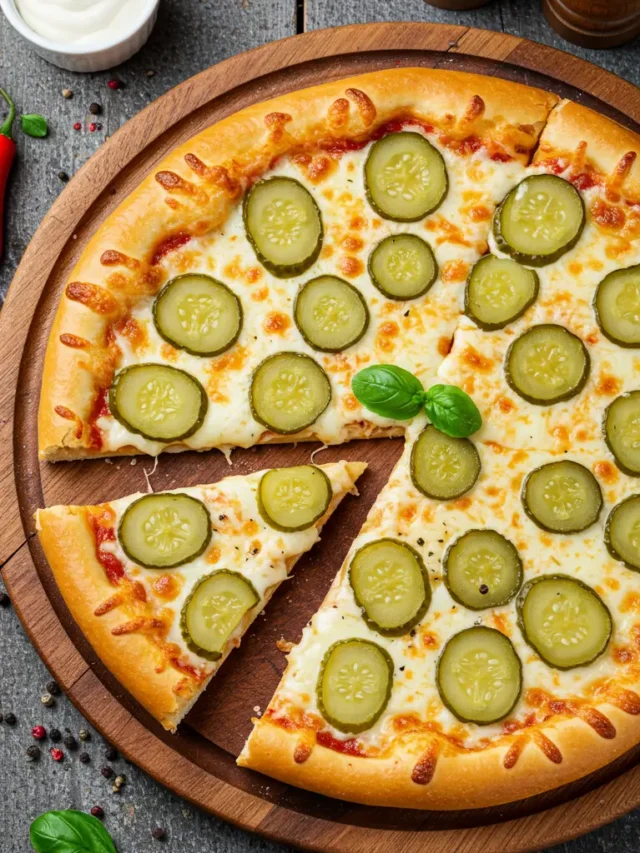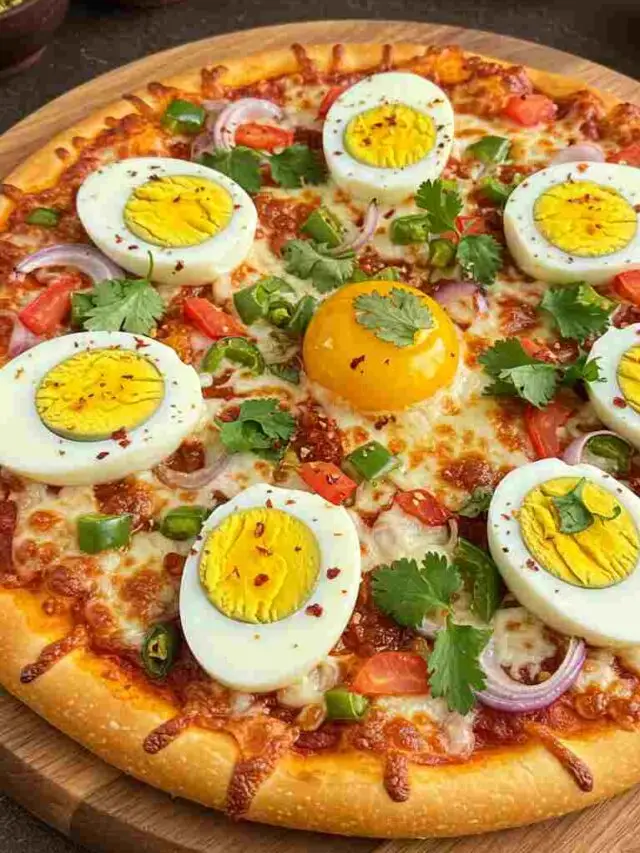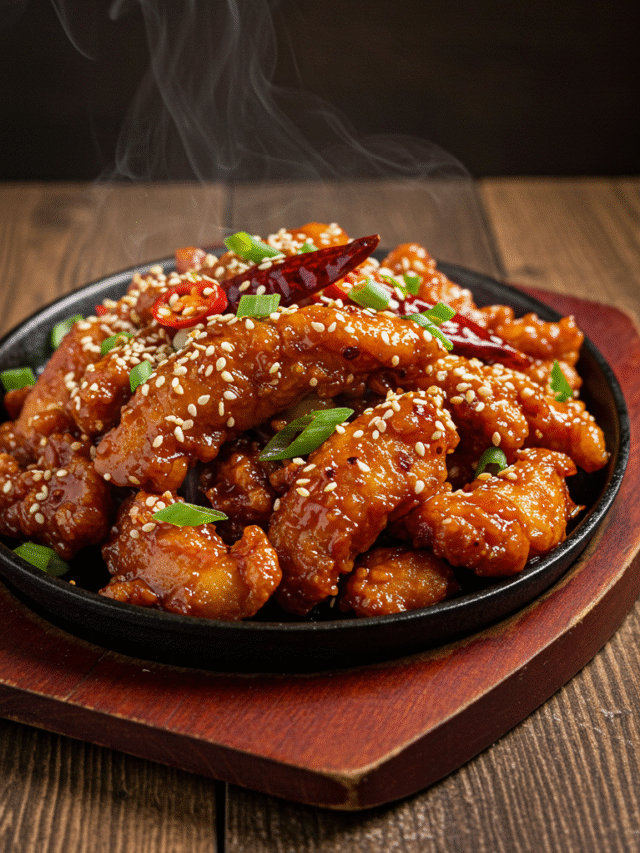Introduction
Nothing brings family and friends together like a hot, fresh supreme pizza straight from your own oven. This classic favorite combines the perfect mix of meats, vegetables, and cheese on a crispy yet chewy crust. Making homemade supreme pizza might seem challenging, but our step-by-step guide will help you create restaurant-quality results right in your kitchen.
Many pizza lovers agree that the key to amazing supreme pizza starts with understanding the right techniques. The experts at King Arthur Baking share professional pizza dough techniques that make a huge difference in your final result. Their tested methods help you avoid common pitfalls that lead to disappointing crusts.
The beauty of supreme pizza lies in its balanced combination of flavors and textures. According to Serious Eats, the science behind perfect pizza crust involves specific ratios of ingredients and proper temperature control. Their research shows that small adjustments in your technique can dramatically improve your pizza’s quality and taste.
What is a Supreme Pizza?
A supreme pizza features a rich tomato sauce base topped with:
- Pepperoni slices – Adding spicy, savory notes
- Italian sausage – Providing hearty, seasoned flavor
- Green bell peppers – For fresh crunch and color
- Red onions – Adding sweet-sharp bite
- Black olives – Contributing briny richness
- Mushrooms – Offering earthy umami depth
- Mozzarella cheese – Creating that classic melty stretch
This combination originated in American pizzerias during the mid-20th century as owners wanted to create an option with “everything” on it. While regional variations exist, these core ingredients define the classic supreme pizza experience.
Unlike other specialty pizzas that focus on one flavor profile, the supreme pizza brings together meats and vegetables in perfect harmony. This balance makes it different from meat-heavy options or vegetable-focused pies. The magic happens when these diverse toppings cook together, with their flavors mixing and complementing each other.
Many people confuse supreme and deluxe pizzas, but key differences exist. Supreme pizzas always include both meats and vegetables, while deluxe versions sometimes skip the meat or focus more on premium cheese blends. Check out our Complete Pizza Styles Guide for a deeper understanding of different pizza variations and their unique characteristics.
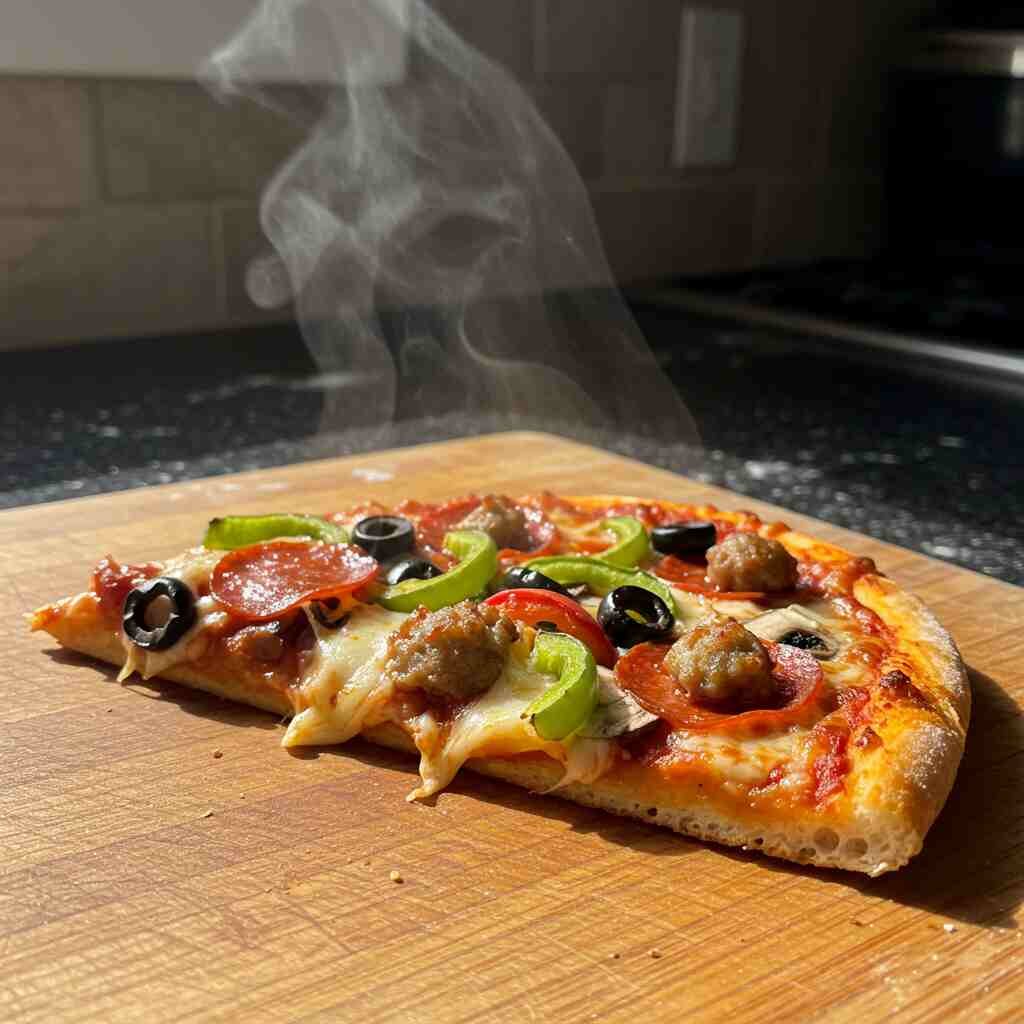
Essential Ingredients for the Perfect Supreme Pizza
The Base Components
Creating amazing supreme pizza starts with three fundamental elements: dough, sauce, and cheese.
For the pizza dough, you can choose between homemade and store-bought options. Homemade dough gives you complete control over flavor and texture, while quality pre-made dough saves time without sacrificing too much quality. Our Homemade Pizza Dough Recipe shows you exactly how to make perfect dough with just a few simple ingredients.
The pizza sauce forms the flavor foundation of your supreme pizza. Traditional red pizza sauce uses San Marzano tomatoes, garlic, and simple seasonings. A good sauce should taste bright and fresh, not overly sweet or acidic. The thickness matters too – too watery and your crust gets soggy, too thick and it won’t spread properly.
For cheese, whole-milk mozzarella delivers the best melt and flavor. Many pizza experts recommend using both fresh and low-moisture mozzarella for optimal results. Fresh provides creaminess, while low-moisture gives you that stretchy pull and better browning. Adding a sprinkle of parmesan or pecorino romano creates depth of flavor that makes your supreme pizza taste professional.
Classic Supreme Toppings
The signature supreme pizza toppings create its distinctive flavor profile. For best results:
- Meats should be pre-cooked – Partially cook sausage and bacon before adding to your pizza to ensure they finish perfectly with the crust
- Cut vegetables uniformly – This helps everything cook at the same rate
- Don’t overload the pizza – Too many toppings lead to soggy centers and undercooked crusts
- Season each layer – A light sprinkle of salt and Italian herbs between layers builds flavor
Quality matters when selecting toppings. Look for pepperoni with natural casings that cup and crisp when baked. Italian sausage should contain fennel and garlic for authentic flavor. For vegetables, fresh options beat pre-cut versions for both taste and texture.
The right topping arrangement also affects your pizza’s final quality. Try placing most vegetables under a light cheese layer to prevent them from drying out. This technique, covered in our Perfect Pizza Assembly Guide, helps maintain moisture while still allowing flavors to meld perfectly.
Supreme Pizza Dough Recipe
Create Perfect Pizza Dough at Home
Making pizza dough from scratch gives your supreme pizza an edge that store-bought options can’t match. This homemade dough recipe creates the ideal base – crispy on the outside, chewy on the inside, and strong enough to hold all those delicious supreme toppings.
The secret to perfect pizza dough lies in understanding a few simple principles. As explained by Food Network, the temperature of your ingredients significantly impacts your final result. They recommend using warm water (around 110°F) to activate the yeast properly without killing it. This small detail makes a huge difference in how your dough rises and develops flavor.
Let’s break down the essential ingredients and steps for making outstanding pizza dough that will take your supreme pizza to new heights.
Ingredients for Supreme Pizza Dough
For two medium (12-inch) pizza crusts, you’ll need:
- 3½ cups all-purpose flour
- 1 packet (2¼ teaspoons) active dry yeast
- 1 tablespoon sugar
- 1½ teaspoons salt
- 1½ cups warm water (110°F)
- 2 tablespoons olive oil, plus extra for the bowl
Step-by-Step Preparation Method
- Mix dry ingredients – Combine flour, yeast, sugar, and salt in a large bowl
- Add wet ingredients – Pour in warm water and olive oil
- Mix until shaggy – Stir everything until the mixture forms a rough, shaggy dough
- Knead the dough – Turn onto a floured surface and knead for 7-10 minutes until smooth and elastic
- First rise – Place in an oiled bowl, cover with a damp cloth, and let rise in a warm spot for 1 hour
- Punch down – Gently press out air bubbles
- Divide and shape – Cut dough in half and form into two balls
- Second rise – Let the dough balls rest, covered, for 20 minutes before shaping
The kneading process develops gluten strands that give your pizza crust its characteristic chew. You’ll know your dough is ready when it passes the “windowpane test” – a small piece stretched between your fingers becomes thin enough to see light through without tearing.
Tips for Perfect Pizza Dough
Making great pizza dough becomes easier with these professional tips:
- Use a kitchen scale – Measuring flour by weight (500g) instead of volume gives more consistent results
- Test water temperature – Too cold and your yeast won’t activate; too hot and you’ll kill it
- Don’t rush the rise – Longer, slower fermentation creates better flavor
- Rest after shaping – Let your stretched dough rest for 5 minutes to prevent shrinkage
- Pre-heat thoroughly – Your oven and pizza stone should heat for at least 45 minutes before baking
For thin-crust lovers, check out our Italian Thin Crust Guide for techniques to achieve that cracker-like crispness that pairs beautifully with supreme toppings.
Make-Ahead and Storage Tips
Pizza dough works perfectly as a make-ahead item:
- Refrigerate – After the first rise, place dough in an oiled ziplock bag for up to 3 days
- Freeze – Wrap individual dough balls tightly in plastic, then foil, and freeze for up to 3 months
- Thaw properly – Move frozen dough to the refrigerator 24 hours before use
- Bring to room temperature – Let cold dough sit at room temperature for at least 30 minutes before shaping
Cold dough fights back when you try to stretch it, so patience pays off. Many pizza experts believe dough that rests overnight in the refrigerator actually develops more complex flavors, making your supreme pizza taste even better.
Homemade Supreme Pizza Sauce
The Secret to Authentic Pizza Flavor
No supreme pizza reaches its full potential without the right sauce. This homemade pizza sauce recipe creates rich, vibrant flavors that lift your pizza from good to incredible. The best part? It takes just minutes to make and tastes far better than any jarred option.
Pizza Sauce Ingredients
For enough sauce to cover two medium pizzas:
- 1 can (28 oz) whole San Marzano tomatoes
- 2 tablespoons olive oil
- 2 garlic cloves, minced
- 1 teaspoon dried oregano
- ½ teaspoon dried basil
- 1 teaspoon salt
- ½ teaspoon sugar (optional)
- Pinch of red pepper flakes
Quick & Easy Preparation
- Drain tomatoes – Pour off excess liquid but save it in case you need to adjust thickness
- Hand-crush tomatoes – Break them up for a rustic texture with small chunks
- Mix ingredients – Combine all ingredients in a bowl
- Let flavors meld – For best results, make your sauce at least 30 minutes before using
Unlike cooked sauces, this no-cook pizza sauce maintains bright, fresh tomato flavor that complements the complex toppings on a supreme pizza. The raw garlic and herbs bloom in the oven’s heat, releasing their aromatics directly into your pizza.
Want to up your sauce game even more? Our Marinara Mastery Guide shows you how small adjustments to your technique can create restaurant-quality results every time.
Flavor Variations
Customize your pizza sauce to match your preferences:
- Spicy version – Double the red pepper flakes and add a dash of cayenne
- Herb-forward – Add 1 tablespoon fresh basil and 1 teaspoon fresh oregano
- Garlic lover’s – Double the garlic and add ¼ teaspoon garlic powder
- Sweet sauce – Increase sugar to 1 teaspoon and add a tablespoon of grated carrot
The beauty of homemade sauce lies in your ability to adjust flavors exactly to your taste. Pizza sauce should complement, not overpower, the wonderful medley of supreme toppings.
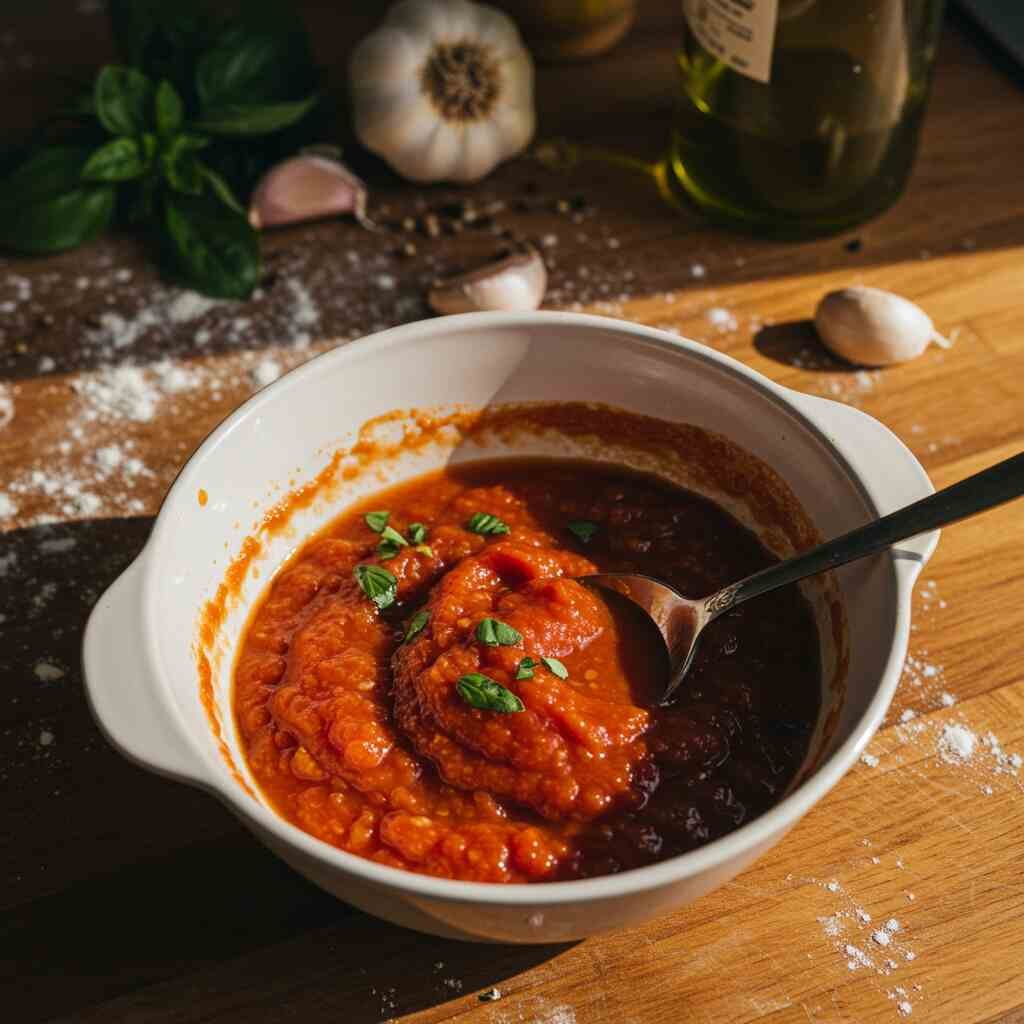
Storage Tips for Pizza Sauce
Make extra sauce and save time on your next pizza night:
- Refrigerate – Store in an airtight container for up to 5 days
- Freeze – Pour into ice cube trays, freeze, then transfer cubes to freezer bags for up to 3 months
- Avoid metal containers – The acid in tomatoes reacts with metal during storage
- Warm before using – Take the chill off refrigerated sauce before spreading on dough
With your dough and sauce mastered, you’re now ready to assemble the ultimate supreme pizza that will impress family and friends alike.
Supreme Pizza Assembly and Cooking Guide
Preparation Steps
The perfect supreme pizza comes together when you build it carefully, layer by layer. This section will show you exactly how to transform your homemade dough and sauce into a mouthwatering pizza topped with the classic supreme combination.
Working with the Dough
Start with your prepared pizza dough at room temperature. Cold dough fights back and shrinks, making it frustrating to work with. Follow these steps for the best results:
- Dust your surface – Sprinkle flour on your counter to prevent sticking
- Press, don’t roll – Use your fingertips to press the dough outward from the center
- Create a rim – Leave the outer edge slightly thicker for a nice crust
- Lift and stretch – Pick up the dough and let gravity help stretch it while you rotate
- Rest if needed – If the dough keeps springing back, let it rest 5 minutes and try again
Remember that pizza dough shouldn’t look perfect. Those irregular bubbles and slightly uneven thickness add character and create varied textures in the finished pizza.
Applying Sauce and Toppings
Building your supreme pizza in the right order makes a huge difference in the final result:
- Sauce first – Spread a thin layer of pizza sauce from the center outward, leaving a 1/2-inch border
- First cheese layer – Sprinkle a light layer of mozzarella (about half your total cheese)
- Add meats – Distribute pepperoni, sausage, and any other meats evenly
- Add vegetables – Scatter mushrooms, peppers, onions, and olives
- Final cheese layer – Top with remaining cheese to help hold everything together
- Finish with seasoning – A light sprinkle of dried oregano and grated parmesan
The key to great supreme pizza toppings is moderation. Too many toppings create a soggy, undercooked center. Aim for a single layer of each ingredient with some dough visible between pieces.
Layering Techniques for Best Results
The way you arrange your supreme pizza toppings affects both appearance and flavor:
- Cut items uniformly – Similar sizes help everything cook at the same rate
- Distribute strategically – Every bite should include multiple toppings
- Protect delicate items – Place mushrooms under some cheese to prevent drying out
- Pre-cook certain vegetables – Briefly sauté bell peppers and onions if you prefer them fully softened
- Use restraint – A supreme pizza needs balance, not an overload of any one ingredient
Professional pizza makers often place certain vegetables under cheese and others on top. This technique cooks each ingredient perfectly while creating beautiful visual appeal.
Cooking Methods
Oven Baking Instructions
Your home oven can create amazing homemade pizza with these techniques:
- Preheat thoroughly – Set your oven to its highest temperature (usually 500-550°F) for at least 30 minutes
- Position rack correctly – Place rack in upper third of oven for best top and bottom cooking
- Transfer with care – Use a floured pizza peel or the back of a baking sheet
- Watch closely – Supreme pizza typically cooks in 8-12 minutes
- Look for visual cues – The crust should be golden brown and cheese bubbling with some browned spots
The high heat quickly cooks the dough while browning the toppings, creating that perfect contrast between crisp exterior and tender interior.
Pizza Stone vs. Baking Sheet
Both tools work well for baking pizza at home:
- Pizza stone advantages:
- Retains high heat for crispy crust
- Absorbs moisture from dough
- Creates more even cooking
- Most similar to pizzeria results
- Baking sheet advantages:
- No preheating required
- Easier to transfer pizza
- More forgiving for beginners
- Works well for thicker crusts
Whichever tool you choose, always preheat it with your oven for the best results with your supreme pizza.
Grill Cooking Option
Grilled supreme pizza offers smoky flavor that ovens can’t match:
- Heat grill – Set up for indirect heat (hot on one side, cooler on the other)
- Par-cook the dough – Grill one side directly over heat for 1-2 minutes
- Flip and top – Move to indirect heat, flip, and quickly add toppings
- Close lid – Cook with lid closed for 5-7 minutes until cheese melts
- Check bottom – The crust should have nice grill marks without burning
This method works particularly well in summer when you don’t want to heat up your kitchen with a hot oven.

Temperature and Timing Recommendations
Different pizza styles need different cooking approaches:
- Thin crust supreme – 500°F for 7-9 minutes
- Medium thickness – 475°F for 10-12 minutes
- Thick crust – 450°F for 15-18 minutes
- Deep dish style – 425°F for 20-25 minutes
Look for these signs that your supreme pizza is perfectly cooked:
- Crust edge is golden brown with some darker spots
- Bottom crust has browned nicely
- Cheese is completely melted with some bubbling
- Toppings look cooked but not burnt
- When lifted, the pizza holds its shape
Let your pizza rest for 1-2 minutes after removing from the oven. This brief pause helps the cheese set slightly, making the first slice cleaner and easier to serve.
Supreme Pizza Variations
Make Your Supreme Pizza Truly Yours
Once you master the classic supreme pizza recipe, you can create exciting variations that match your tastes and preferences. These adaptations keep the spirit of supreme pizza while adding personal touches that make your creation unique.
Meat Lover’s Supreme
For meat enthusiasts, this supreme pizza variation packs extra protein and savory flavors:
- Double the pepperoni – Add a second layer of thinly sliced pepperoni
- Add bacon – Sprinkle pre-cooked, crumbled bacon throughout
- Try Italian beef – Thinly sliced roast beef adds rich flavor
- Include prosciutto – Add after baking for a gourmet touch
- Mix up the sausage – Combine sweet and hot Italian sausage
The key to a great meat lover’s supreme lies in balancing the different proteins. Too much of one meat overwhelms the others. Use about 25% more meat than a standard supreme pizza, but distribute it evenly among your chosen varieties.
Each meat brings its own fat content to your pizza. Consider reducing cheese slightly (by about 15-20%) to prevent your pizza from becoming too greasy.
Veggie Supreme
This plant-focused pizza variation celebrates fresh vegetables and bright flavors:
- Add artichoke hearts – They bring buttery richness
- Include roasted red peppers – Sweet and smoky flavors
- Try fresh tomato slices – Add these after baking
- Sprinkle baby spinach – A nutritious addition that wilts perfectly in the oven
- Add fresh basil – Sprinkle on after baking for aromatic brightness
- Consider sun-dried tomatoes – Intense sweet-tart flavor in small doses
Vegetable pizza toppings release moisture during cooking. To prevent soggy pizza, slice vegetables thinly and avoid overloading your pizza. For particularly wet vegetables like zucchini or eggplant, salt the slices and let them sit for 15 minutes, then pat dry before adding to your pizza.
For extra flavor, toss your vegetables in a little olive oil with Italian herbs before adding them to your pizza.
Gourmet Supreme
Take your homemade supreme pizza to restaurant quality with these premium touches:
- Use specialty meats – Try sopressata, capicola, or nduja
- Add cheese variety – Mix in fontina, provolone, or fresh burrata (add after baking)
- Include roasted garlic – Sweet, mellow garlic flavor throughout
- Try truffle oil – Just a few drops after baking adds luxury
- Add caramelized onions – Sweet depth that complements other toppings
- Finish with fresh herbs – Basil, oregano, or thyme add color and aroma
The best gourmet pizza recipes focus on quality over quantity. Choose a few exceptional ingredients rather than crowding your pizza with many average ones. Allow each premium ingredient to shine by pairing it with complementary flavors.
Consider a drizzle of high-quality extra virgin olive oil or aged balsamic glaze just before serving to add a professional finishing touch.
Dietary Alternatives
Everyone deserves great supreme pizza, regardless of dietary needs:
Gluten-Free Supreme
- Use cauliflower crust – Now widely available pre-made or make your own
- Try almond flour crust – Adds nutty flavor and holds up well
- Consider cornmeal crust – Adds pleasant texture and flavor
- Check all toppings – Some processed meats contain hidden gluten
Gluten-free pizza works best when slightly thinner than regular crust. The toppings should also be slightly less heavy to prevent the more delicate crust from collapsing.
Low-Carb Supreme
- Try cheese-based crust – Mostly cheese with minimal flour
- Make chicken crust – Ground chicken mixed with parmesan creates a protein-rich base
- Consider portobello caps – Individual mushroom “pizzas” with all the supreme toppings
- Use zucchini boats – Halved and hollowed zucchini makes great personal pizza bases
Low-carb pizza options often cook faster than traditional dough. Watch closely and reduce cooking time by 25-30% to prevent burning.
Dairy-Free Supreme
- Use nutritional yeast – Adds cheese-like flavor
- Try cashew “cheese” sauce – Creates creamy texture
- Consider store-bought alternatives – Many vegan mozzarella options now melt well
- Add extra olive oil – Helps replace the richness that cheese provides
The best dairy-free pizza replaces not just the cheese itself but the creamy mouthfeel it provides. A combination of plant-based cheese and healthy fats achieves this balance.
Serving and Pairing Suggestions
Complete Your Supreme Pizza Experience
The right accompaniments make your homemade supreme pizza the centerpiece of a memorable meal. From sides to drinks, these pairings highlight and complement the rich flavors of your supreme creation.
Best Side Dishes
Classic sides that pair perfectly with supreme pizza:
- Simple green salad – The crisp freshness balances the rich pizza
- Garlic knots – Use extra pizza dough to create these crowd-pleasers
- Antipasto platter – Italian meats, cheeses, olives and marinated vegetables
- Buffalo wings – A popular pizza companion for good reason
- Roasted vegetables – Eggplant, zucchini and bell peppers roasted with Italian herbs
For family pizza night, set up a buffet of sides so everyone can customize their meal. Light sides work best, as the pizza itself is filling and satisfying.
Beverage Pairings
The right drinks make supreme pizza even better:
- Italian red wines – Chianti, Barbera, or Primitivo cut through the richness
- Craft beer – IPAs and pale ales complement the savory flavors
- Italian sodas – The sweet-tart flavors refresh the palate
- Sparkling water with lemon – Cleanses the palate between bites
- Iced tea – Particularly good with spicier supreme variations
For the full Italian pizza experience, consider serving a small glass of limoncello after the meal as a digestif.
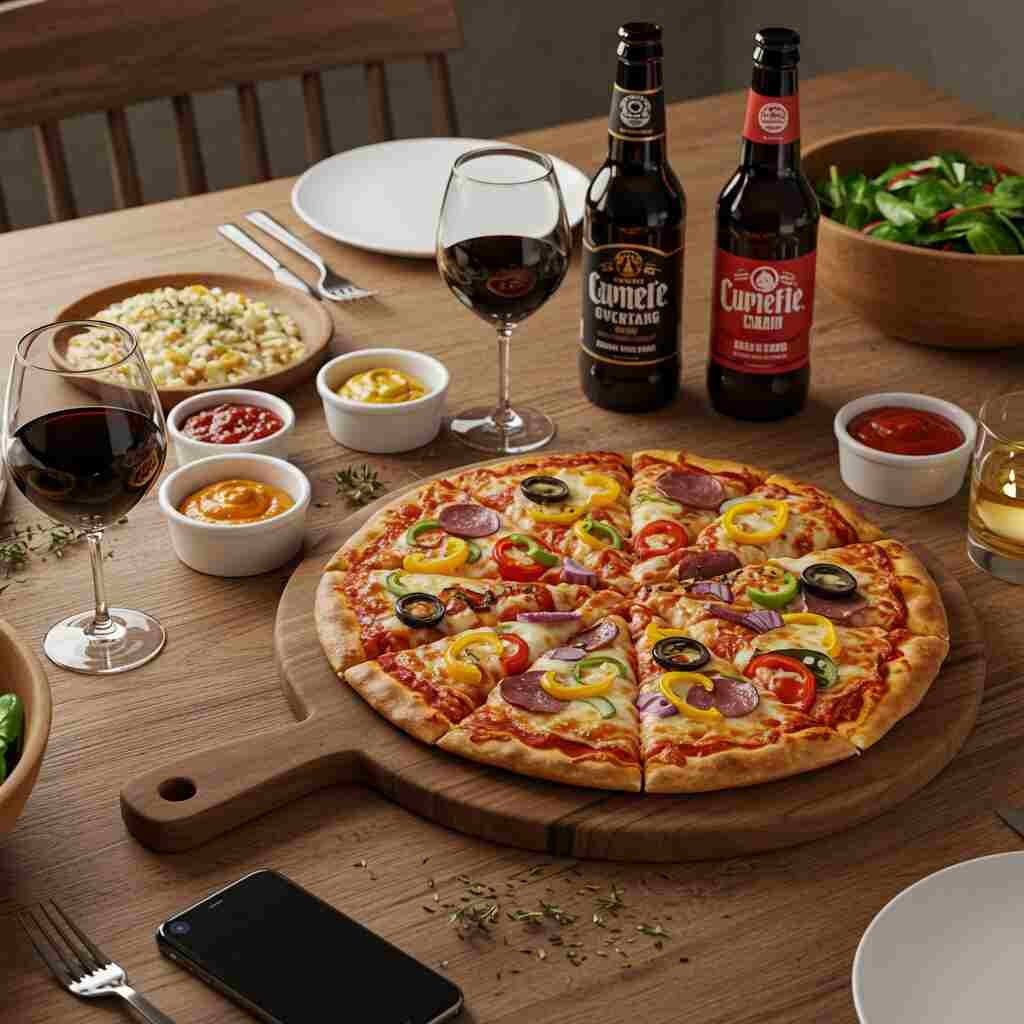
Dipping Sauces
Extra sauces add fun and flavor to your pizza night:
- Garlic butter – Brush on the crust or dip after baking
- Ranch dressing – An American classic pizza companion
- Hot honey – Sweet heat that works wonderfully with the salty toppings
- Extra pizza sauce – Warm it slightly before serving
- Pesto – The herb flavors complement the supreme toppings
Small ramekins of dipping sauces let everyone customize their pizza experience without overwhelming the carefully balanced flavors of your supreme pizza.
Family-Style Serving Ideas
Make pizza night special with these serving suggestions:
- Use a pizza stand – Raises the pizza for easy access and saves table space
- Provide pizza scissors – Easier than a wheel cutter for many people
- Warm the plates – Place plates in a low oven (200°F) for 5 minutes before serving
- Create a topping bar – Extra toppings let guests add final touches
- Slice strategically – Cut smaller slices so people can try different variations
For the best family dinner experience, serve pizza fresh from the oven in batches rather than making all pizzas ahead of time. The difference in taste and texture between fresh and sitting pizza is remarkable.
FAQs About Supreme Pizza
Common Questions About Supreme Pizza Answered
Many people have questions about supreme pizza – from its traditional ingredients to how different restaurants prepare it. Here, we answer the most common questions to help you understand everything about this popular pizza style.
What is usually on a supreme pizza?
A traditional supreme pizza includes:
Pepperoni – Spicy cured meat that creates red, crispy discs when baked
Italian sausage – Typically removed from casing and crumbled
Green bell peppers – Sliced thin for even cooking
Red onions – Adds sweet-sharp flavor and purple color
Black olives – Sliced for even distribution
Mushrooms – Fresh, not canned, for best flavor
Mozzarella cheese – The primary cheese, sometimes mixed with provolone
The classic supreme combines these ingredients on a tomato sauce base. Regional variations exist, but these core toppings define the supreme style. The beauty of this combination lies in how the flavors complement each other – the spicy meats balance with the earthy mushrooms, while the peppers and onions add freshness and crunch.
What toppings are on a Domino’s Supreme pizza?
Domino’s calls their version the “Ultimate Pepperoni” or “ExtravaganZZa” and includes:
Pepperoni – Extra portions compared to their standard pizza
Italian sausage – Seasoned with fennel and garlic
Beef – Finely crumbled ground beef
Green bell peppers – Fresh, not pre-cooked
Onions – White onions rather than red
Mushrooms – Sliced button mushrooms
Black olives – Medium sliced
Extra cheese – Heavier cheese coverage than standard pizzas
Many pizza chains create their own version of the supreme pizza. Domino’s version includes more meat varieties than some traditional supreme pizzas. They also use a more generous amount of cheese to hold the abundant toppings in place during delivery.
What is the difference between supreme and deluxe pizza?
The key differences between supreme and deluxe pizza include:
Meat selection – Supreme always includes pepperoni and Italian sausage; deluxe might use ham instead
Vegetable variety – Deluxe often adds extra vegetables like tomato slices
Cheese blend – Deluxe typically uses a more complex cheese mixture
Sauce base – Some deluxe pizzas use white or pesto sauce instead of tomato
Crust type – Deluxe often comes on a thicker, more substantial crust
Pizza terminology varies between regions and restaurants. In some places, “deluxe” means a more premium version of supreme with higher-quality ingredients. In others, the terms are used almost interchangeably. When ordering at a new pizza place, ask what specifically comes on their supreme or deluxe options.
What is the ultimate supreme pizza?What is the ultimate supreme pizza?
The ultimate supreme pizza typically includes:
All traditional supreme toppings – Pepperoni, sausage, peppers, onions, olives, mushrooms
Additional meats – Often bacon, ham, and sometimes ground beef
Extra cheese varieties – Provolone, parmesan, or romano added to mozzarella
Special sauce – Often a zestier or spicier version of standard pizza sauce
Herb finish – Fresh basil or an Italian herb blend sprinkled after baking
This loaded pizza option represents the “everything” pizza taken to its extreme. While delicious, the ultimate supreme needs careful construction to avoid becoming soggy from too many toppings. The crust must be sturdy enough to support the weight, and pre-cooking some vegetables helps reduce excess moisture.
What are the specialty pizzas at Pizza Hut?
Pizza Hut offers several specialty pizzas including:
Supreme – Their classic version with pepperoni, sausage, beef, green peppers, mushrooms, and red onions
Meat Lover’s – Pepperoni, ham, beef, bacon, sausage, and pork
Veggie Lover’s – Green peppers, onions, mushrooms, tomatoes, and black olives
Pepperoni Lover’s – Extra pepperoni and extra cheese
Chicken Supreme – Grilled chicken with vegetables
BBQ Lover’s – BBQ sauce base with chicken, bacon, and onions
The number of pizza slices depends on the size and shop:
Pizza Hut’s signature supreme differs slightly from the traditional recipe by adding beef and sometimes ham. They also offer this pizza on all their crust styles: Original Pan, Hand-Tossed, Thin ‘N Crispy, and Stuffed Crust.
How many pieces are in a Supreme Pizza?
Small (10″) – Usually cut into 6 slices
Medium (12″) – Typically 8 slices
Large (14″) – Most often 8 or 10 slices
X-Large (16″+) – Generally 12 slices
Party size – Can have 16 or more slices
Most pizza restaurants cut round pizzas in a star pattern from the center. Square-cut pizza (sometimes called “party cut” or “tavern cut”) creates smaller, rectangular pieces that work well for appetizers or large groups.
For homemade supreme pizza, you choose how many slices to cut. For parties, consider cutting smaller slices since supreme pizza is quite filling with all its toppings.
Troubleshooting Common Supreme Pizza Problems
Solutions for Perfect Pizza Every Time
Even experienced pizza makers run into challenges. Here are fixes for the most common supreme pizza problems you might face at home.
Dealing with Soggy Crusts
A soggy pizza bottom ruins an otherwise perfect supreme pizza. Try these solutions:
- Drain wet toppings – Pat mushrooms, pineapple, and other wet items with paper towels
- Pre-cook watery vegetables – Sauté bell peppers and onions briefly to remove moisture
- Use less sauce – A thin layer works better than a thick one
- Pre-bake the crust – Bake just the dough for 3-4 minutes before adding toppings
- Use a pizza stone – Preheat it thoroughly for at least 45 minutes
- Lower oven rack – Position your pizza lower in the oven for more bottom heat
- Check oven temperature – Many home ovens run cooler than their setting indicates
The perfect pizza crust needs intense heat from below. If you consistently get soggy bottoms, consider using a pizza steel instead of a stone, as it conducts heat more efficiently.
Making Perfect Pizza Every Time
Preventing Burnt Toppings
While you want a nicely browned crust, burnt pizza toppings ruin the flavor of your supreme pizza. Here’s how to avoid this common problem:
- Adjust oven rack position – Move pizza to a lower rack if tops cook too quickly
- Add cheese strategically – Cover delicate toppings with a light layer of cheese
- Watch cooking time carefully – Set a timer for 2 minutes less than recipe suggests
- Create foil shields – Loosely cover edges with foil strips if they brown too fast
- Lower oven temperature – Try 25°F lower with a slightly longer cook time
- Add delicate toppings later – Put items like fresh basil on during the last 2 minutes
The high heat needed for crispy pizza crust can sometimes burn toppings, especially in supreme pizzas with many ingredients. Finding the right balance takes practice, but the results are worth it.
Some home cooks find success with the “two-temperature method”: start at 500°F for the first 5 minutes, then reduce to 450°F to finish cooking without burning the toppings.
Solutions for Uneven Cooking
Uneven pizza baking happens when some parts cook faster than others. Try these fixes:
- Rotate pizza halfway – Turn it 180 degrees during cooking
- Check for oven hot spots – Many home ovens have temperature variations
- Distribute toppings evenly – Avoid piling toppings in the center
- Create consistent thickness – Make your dough even throughout
- Preheat thoroughly – Give your oven and stone/steel at least 45-60 minutes
- Don’t open the oven door – Each opening drops temperature significantly
A properly cooked supreme pizza should have even browning across the bottom and top. If you notice consistent problems with uneven cooking, consider using an oven thermometer to check your actual temperature.
Fixing Cheese Issues
Perfect melted cheese makes a supreme pizza irresistible. Solve these common cheese problems:
Cheese That Won’t Melt Properly
- Use the right cheese – Fresh mozzarella contains more moisture and melts differently
- Grate your own – Pre-shredded cheese contains anti-caking agents that affect melting
- Bring cheese to room temperature – Cold cheese takes longer to melt
- Check fat content – Low-fat cheeses don’t melt as smoothly
- Mix cheese varieties – Combine mozzarella with provolone or fontina for better melting
Cheese That Burns Before Crust Cooks
- Add cheese later – Put it on halfway through cooking
- Use larger cheese pieces – Thicker slices melt more slowly than fine shreds
- Create a barrier – Place cheese under toppings rather than on top
- Try a blend with lower-moisture cheeses – They brown more slowly
The perfect cheese pull – that stretchy, Instagram-worthy moment – comes from using whole-milk mozzarella combined with proper cooking and resting time. Let your pizza cool for 2-3 minutes after baking to allow cheese to set slightly.
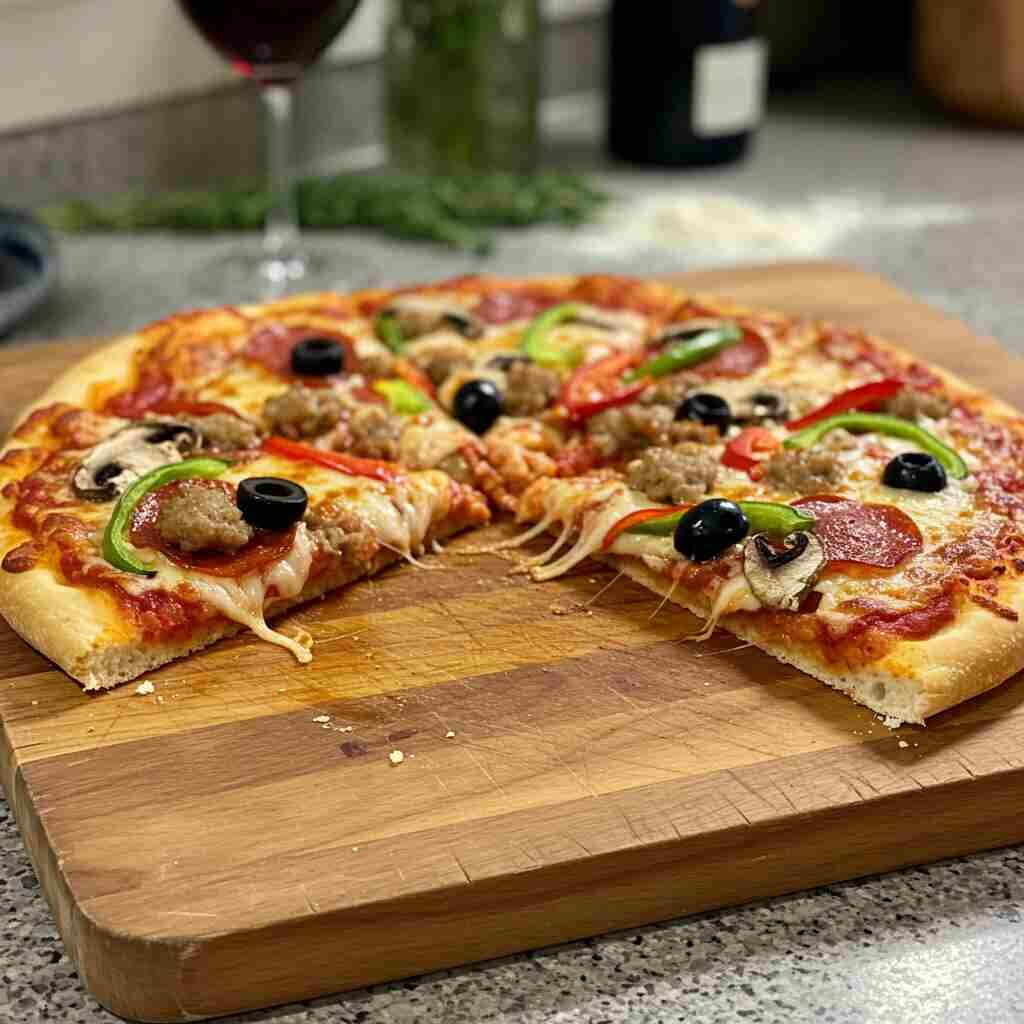
Conclusion
Your Journey to Supreme Pizza Mastery
Creating the perfect homemade supreme pizza takes practice, but the results are truly worth the effort. The combination of crispy crust, savory sauce, melty cheese, and the classic medley of toppings creates a dining experience that brings people together.
Recipe Recap
Your path to supreme pizza perfection includes:
- Making dough with care – Whether by hand or machine, good dough needs proper kneading and resting
- Creating balanced sauce – Not too sweet, not too acidic, with just the right herbs
- Choosing quality toppings – Fresh ingredients make all the difference
- Layering strategically – The order of toppings affects cooking and flavor
- Cooking with high heat – The secret to restaurant-quality results
- Troubleshooting problems – Learning from mistakes improves your next pizza
The beauty of pizza making lies in how personal it becomes. Over time, you’ll develop your own techniques and preferences that make your supreme pizza unique.
Final Tips for Success
Take your pizza skills to the next level with these final suggestions:
- Keep notes – Track what works and what doesn’t in your kitchen
- Practice dough handling – The more you work with it, the better you’ll understand it
- Try different flours – Bread flour, 00 flour, and all-purpose create different textures
- Invest in tools gradually – Start simple, then add pizza stones, peels, and other tools as you go
- Have fun experimenting – Pizza making should be enjoyable, not stressful
Remember that even “imperfect” pizza usually tastes amazing. The homemade pizza experience – the process, the aromas filling your kitchen, and the satisfaction of creating with your hands – adds something special that delivery can never match.
Encouragement to Experiment
Now that you understand the fundamentals of supreme pizza, feel free to make it your own:
- Try regional styles – New York thin crust, Chicago deep dish, Detroit style
- Explore global flavors – Add international ingredients for fusion pizzas
- Create seasonal versions – Use fresh, local produce at its peak
- Make it a social event – Pizza-making parties let everyone customize their perfect slice
- Challenge yourself – Tackle advanced techniques like sourdough crust or wood-fired methods
The best pizza recipes often come from creative experiments and happy accidents. Your perfect supreme pizza might include an unexpected ingredient or technique that becomes your signature style.
Additional Resources and References
For those looking to continue their pizza journey, consider these additional resources:
- Classic Italian cookbooks focusing on regional pizza styles
- Online pizza forums where enthusiasts share tips and recipes
- Local cooking classes that specialize in pizza techniques
- Pizza blogs with step-by-step photo tutorials
- Video channels dedicated to home pizza making
The world of pizza making is vast and welcoming. Whether you’re making a simple supreme pizza for family dinner or exploring advanced techniques, remember that the best pizza is the one made with care and shared with others.
Discover Quick & Fun Recipes on TikTok with ToDaRecipes
Looking for fast, visual inspiration to spice up your meals? At ToDaRecipes, we love sharing easy, creative, and delicious recipes that anyone can try at home—and TikTok is the perfect place to see them in action!
Whether you’re into juicy burgers, refreshing drinks, or sweet desserts, our TikTok videos show step-by-step instructions in under a minute. It’s the fastest way to get inspired and start cooking.
👉 Check out our TikTok here: ToDaRecipes on TikTok and follow us for bite-sized kitchen magic!
Explore trending food ideas, kitchen hacks, and recipe tutorials designed to make cooking fun and simple. Don’t just read the recipe—watch it come to life!


